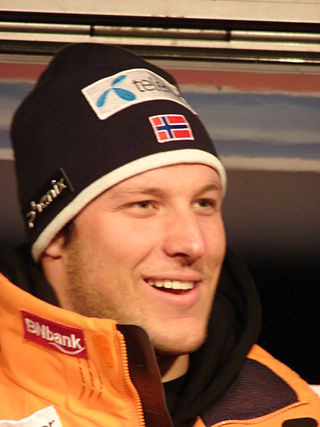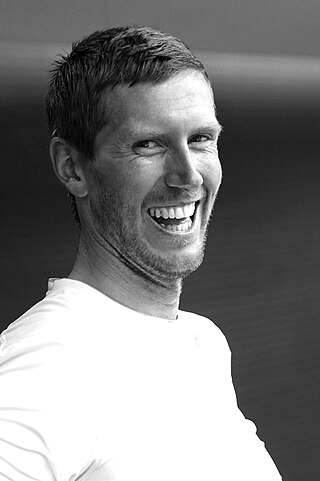
Alberto Tomba is a former World Cup alpine ski racer from Italy. He was the dominant technical skier in the late 1980s and 1990s. At 182 cm and 90 kg, his powerful build was a contrast to the lighter, more traditional technical skiers who prioritised agility over muscle. Tomba was able to take advantage of the introduction of spring-loaded ski gates which replaced the older, solid gates in the early 1980s by using his power to maintain a faster, more direct line through courses. Tomba won three Olympic gold medals, two World Championships, and nine World Cup season titles: four in slalom, four in giant slalom, and one overall title. He was popularly called Tomba la Bomba.

Giorgio Rocca is an Italian former alpine skier, a specialist in slalom skiing. Together with Marc Girardelli, Ingemar Stenmark and Marcel Hirscher, he is one of four skiers to have won 5 Alpine Skiing World Cup slaloms in a row, which he achieved in the 2005/2006 season: only Alberto Tomba (7) has won more World Cup slaloms consecutively. He is currently ninth in the list of all-time slalom winners, with a total of 11 victories.

Didier Cuche is a former World Cup alpine ski racer from Switzerland.

Theodore Sharp Ligety is a retired American alpine ski racer, a two-time Olympic gold medalist, and an entrepreneur, having cofounded Shred Optics. Ligety won the combined event at the 2006 Olympics in Turin and the giant slalom race at the 2014 Olympics in Sochi. He is also a five-time World Cup champion in giant slalom. Ligety won the gold medal in the giant slalom at the 2011 World Championships. He successfully defended his world title in giant slalom in 2013 in Schladming, Austria, where he also won an unexpected gold medal in the super-G and a third gold medal in the super combined.
The 37th World Cup season began in October 2002 on Sölden, Austria, and concluded in March 2003 at the World Cup finals in Lillehammer, Norway. The overall winners were Stephan Eberharter of Austria and Janica Kostelić of Croatia.
The 35th World Cup season began in October 2000 in Sölden, Austria, and concluded in March 2001 at the World Cup finals at Åre, Sweden. The overall winners were Hermann Maier of Austria, his third, and Janica Kostelić of Croatia, her first. Maier won 13 races and had nearly twice the points of his nearest competitor, compatriot Stephan Eberharter. In the women's competition, Kostelić won nine races and won the overall by 67 points over Renate Götschl of Austria. There were no North Americans in the top ten of either competition.
The 23rd World Cup season began in November 1988 in Austria and concluded in March 1989 in Japan. The overall champions were Marc Girardelli of Luxembourg and Vreni Schneider of Switzerland. Schneider established the record for victories in a World Cup season, winning a total of 14 races, surpassing the record of 13 established in 1978-79 by the great Swedish skier and three-time overall World Cup champion Ingemar Stenmark.

The 41st World Cup season was scheduled to begin on 28 October 2006, but cancellation of the opening races in Sölden delayed the season's start by two weeks. A very poor snowpack in the Alps, along with stormy weather in January, caused numerous races to be moved and rescheduled throughout the winter. The schedule included a mid-season break during the first 3 weeks of February for the World Championships in Åre, Sweden. The season concluded on 18 March 2007, at the World Cup Finals in Lenzerheide, Switzerland.

Markus Wasmeier (German pronunciation: [ˈmaʁ.kʊs ˈvaːsˌmaɪ̯ɐ]; born 9 September 1963 is a former World Cup alpine ski racer from Germany. He was World champion and two times Olympic champion.
Andreas "Andi" Schifferer is a former Austrian alpine skier who was known to be a downhill specialist, but also competed in other disciplines.

Manfred Mölgg is an Italian former World Cup alpine ski racer. He specialized in the technical events of slalom and giant slalom.

Andrej Šporn is a former Slovenian alpine skier.

Werner Heel is an Italian former World Cup alpine ski racer.

Kjetil Jansrud is a Norwegian former World Cup alpine ski racer and Olympic champion. He competed in all alpine disciplines apart from slalom, and his best event was the giant slalom where he has six World Cup podiums and an Olympic silver medal. Since 2012, he had concentrated on the speed events, where all but two of his World Cup victories had come. At the 2014 Winter Olympics in Sochi, he won the super-G and placed third in the downhill. At the World Championships in 2019 at Åre, Jansrud won gold in the downhill.

The 45th World Cup season began on 23 October 2010, in Sölden, Austria, and concluded on 20 March 2011, at the World Cup finals in Lenzerheide, Switzerland.
Richard Kröll was an Austrian alpine skier.

The 48th World Cup season began on 26 October 2013, in Sölden, Austria, and concluded on 16 March 2014 at the World Cup finals in Lenzerheide, Switzerland. The defending overall champions from the 2013 season were Marcel Hirscher of Austria and Tina Maze of Slovenia. The overall titles were won by Hirscher and Anna Fenninger, also of Austria. The season was interrupted by the 2014 Winter Olympics that took place from 7 to 23 February in Sochi, Russia, with the alpine events at Rosa Khutor.

Matthias Mayer is an Austrian retired World Cup alpine ski racer and Olympic champion.
Tanguy Nef is a Swiss alpine skier.













